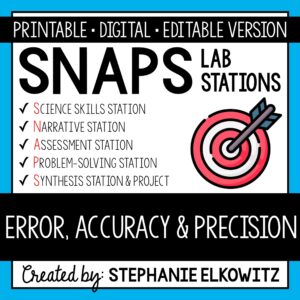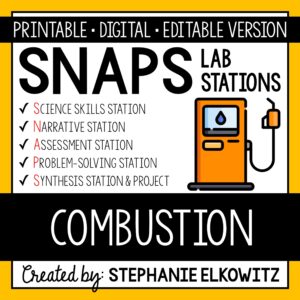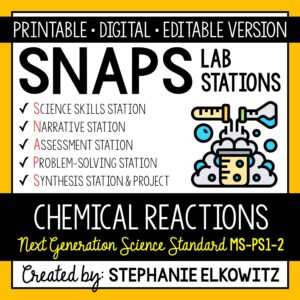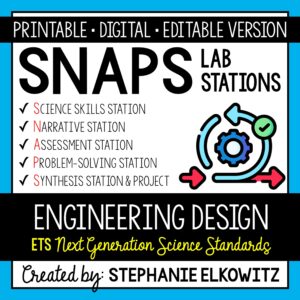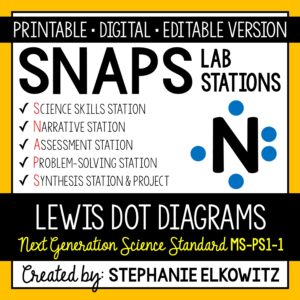MS-ESS3-4 Human Population Growth Lab
$7.00
An engaging lab activity designed to enhance students’ understanding of human population growth and help students apply scientific ideas to the real world. Aligned with NGSS MS-ESS3-4.
Description
MS-ESS3-4 Human Population Growth Lab Preview
SNAPs Lab Stations Activities require students to use science, math, literacy, problem-solving and engineering skills. They are designed to enhance students’ understanding of scientific concepts and help students apply scientific ideas to the real world. Each station activity promotes skills so to develop students into proficient and competent scientific thinkers.
SNAPs lab activities have five components:
• Science Skills Station to develop science skill proficiency
• Narrative Station to build science literacy
• Assessment Station to evaluate learning and understanding
• Problem-Solving Station to foster engineering design
• Synthesis Station and Project to inspire higher-order learning
DIGITAL LABORATORY – DISTANCE LEARNING & DIGITAL CLASSROOMS
• This lab is offered in a digital format to support digital classrooms & distance learning.
• The digital lab activity is designed to work with Google Slides and Microsoft PowerPoint
• The digital lab activity CANNOT be edited. However:
– Students can manipulate text boxes
– Students can create tables, graphs and diagrams
– Students can insert images and drawings
GOOGLE FORM ASSESSMENT STATION
• The assessment station is offered as a self-grading Google Form.
• Questions are all short answer and are 100% editable.
• Suggestions for use are included in the download.
DISTANCE LEARNING COMPATIBILITY
SNAPs lab activities are rated for their ease with distance – independent learning. Refer to the preview for more information about how well this laboratory works in a fully digital classroom and with distance learning.
EDITABLE DOCUMENTS
This download includes an editable word document (docx file) of all lab components:
• Pre-Lab and Post-Lab Activities
• The Lab Overview
• Lab Station Activities and Questions
• Directed Synthesis Project (when applicable)
Important Notes:
• Diagrams, illustrations, tables and graphs essential to lab activities are included
• Illustrative clipart is NOT included
• Editable documents and rubrics are included with the FREE SNAPs Setup Guide
Editable files allow you to:
• Edit the scope of the activities so to suit your students’ needs
• Edit the materials required based on resource availability
• Create single-period “mini-labs” using activities at the individual skills stations
The activities at each station in this lab are detailed below.
Human Population Growth Lab Stations Activity Learning Objectives:
1. Describe human population growth.
2. Discuss how population growth impacts the biosphere.
3. Discuss how total and per-capita consumption of Earth’s natural resources changes with human population growth.
4. Debate solutions to problems associated with human overpopulation.
Science Skills Station
Students will graph the global human population to learn how human population growth has changed over the years and how it might change in the future. Students will study graphs of global birth rates, death rates, life expectancy and population growth rates to better understand how and why our population is changing.
Narrative Station
Students will read about the negative impact a growing human population has on the environment and natural resources. Students will study current data on the total and per capita consumption of natural resources and make projections on how per capita consumption of natural resources impacts the environment.
Assessment Station
At this station, students will answer questions about key terms and ideas relating to human population growth and its impact on the environment. Students will have to employ lower, mid and higher-order thinking skills to answer these questions.
Problem-Solving Station
Students will evaluate the benefits, costs, feasibility and ethicality of proposed and implemented solutions that deal with human overpopulation. Students will also develop their own solutions and evaluate their benefits, costs, practicality and ethicality.
Synthesis Station
Students will compose a CER (claim-evidence-reasoning) report to summarize the lab. Students are provided the claim statement and must support the claim with observations, data and other information gathered in the lab. Students will explain how the evidence supports the claim using scientific reasoning.
Synthesis Project
Students will have a choice of 11 projects. Refer to the SNAPs Lab Stations Best Practices and Setup Guide for directions and suggestions on how to conduct the project.
Directed Synthesis Project
Students can conduct one of the 11 standard synthesis projects, but I strongly suggest using the directed synthesis project to supplement NGSS MS-ESS3-4. In the directed synthesis project, students will discuss how human population growth impacts the environment. They will form an argument that disputes for or against a need to address human population growth. In the argument, students will cite evidence (either obtained in this lab or from credible sources) that supports their claim. Students will use appropriate and respectful language in their arguments.
This download includes:
• A pre-lab assignment and post-lab reflection
• Directions and questions for each lab station
• Student recording sheets
• Teacher Key
Additional Materials Required:
3 Computers or Tablets
NEXT GENERATION SCIENCE STANDARDS
This laboratory satisfies NGSS MS-ESS3-4. It combines the three dimensions of science learning – science and engineering practices, disciplinary core ideas and crosscutting concepts – to meet the standard. This lab also makes interdisciplinary connections to STEM, Math CCSS and ELA CCSS to build the appropriate skills.
TERMS OF USE
• All rights reserved by Stephanie Elkowitz.
• This product is to be used by the original purchaser only.
• Intended for classroom and personal use only.
• Copying for more than one teacher, classroom, department, school, or school system is prohibited.
• This product may not be distributed or displayed digitally for public view.
• Failure to comply is a copyright infringement and a violation of the Digital Millennium Copyright Act (DMCA).




